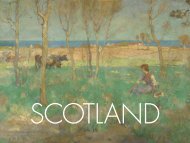Create successful ePaper yourself
Turn your PDF publications into a flip-book with our unique Google optimized e-Paper software.
[22] The Lime-Burner, 1859<br />
Etching and drypoint, printed in warm black ink on thin laid Japan<br />
paper, an impression in the second (final) state, aside from the<br />
edition published in the Thames Set<br />
9 3/4 x 6 7/8 inches (24.9 x 17.2 cm)<br />
sheet 14 1/8 x 8 x 3/4 inches (36 x 22.5 cm)<br />
Reference: Kennedy 46; Glasgow 55<br />
Using an upright format, Whistler shows the Thames<br />
from the shore, leading the eye through a succession of<br />
timber buildings to a small vignette of the river and the<br />
opposite bank, placed just left of centre. The premises of<br />
William Jones & Co were at 241 and 242 Wapping High<br />
Street, a few doors from the sites of Thames Police and<br />
Eagle Wharf. Although this work is widely known as The<br />
Lime-Burner, it was initially given the title W. Jones, Limeburner,<br />
Thames Street when it was shown at the Royal<br />
Academy of Arts the summer after it was made. This<br />
original title shows Whistler as a committed Realist,<br />
choosing a subject from modern life and specifically<br />
identifying the working man in the picture.<br />
After its first showing at the Royal Academy in 1860<br />
(943), it was exhibited in The Works of James Whistler<br />
– Etchings and Dry Points at E. Thomas’s print shop at<br />
39 Old Bond Street in 1861. The subject was published<br />
in the Thames Set; no.9. The plate was sold by F. Keppel<br />
& Co. to Charles Lang Freer in 1896 and is now in the<br />
Freer Gallery of Art.<br />
36 london and the thames



